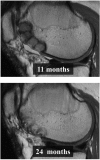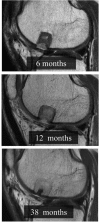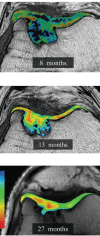The Maturation of Synthetic Scaffolds for Osteochondral Donor Sites of the Knee: An MRI and T2-Mapping Analysis
- PMID: 26069533
- PMCID: PMC4440610
- DOI: 10.1177/1947603509355970
The Maturation of Synthetic Scaffolds for Osteochondral Donor Sites of the Knee: An MRI and T2-Mapping Analysis
Abstract
Objective: The purpose of this study was to analyze the morphological imaging characteristics and incorporation of TruFit bone graft substitute (BGS) plugs using cartilage-sensitive magnetic resonance imaging (MRI) and quantitative T2 mapping.
Design: Twenty-six patients (mean age, 28.72 years; range, 11-56 years) underwent osteochondral autologous transplantation (OATS) for chondral defects with filling of the knee joint donor sites using Trufit BGS plugs. The mean follow-up interval between implantation and MRI analysis was 21.3 months (range, 6-39 months). During this period, 43 cartilage-sensitive and 25 quantitative T2-mapping MRI studies were performed. The donor sites were assessed for plug and interface morphology, displacement, hypertrophy, subchondral edema, presence of bony overgrowth, percentage fill, and degree of incorporation. T2 relaxation times were measured for the superficial and deep layers of the repair tissue. A linear regression and correlational analysis was performed with Bonferroni correction, and P < 0.05 was defined as significant.
Results: Longitudinal analysis revealed favorable plug appearance at early follow-up (≤6 months), with 75% of plugs demonstrating flush morphology and 78% demonstrating near complete to complete fill. Plug appearance deteriorated at intermediate follow-up (~12 months), with only 26% of plugs demonstrating flush morphology and 52% with near complete or complete fill. Plug appearance substantially improved with longer follow-up (≥16 months), with 70% of plugs demonstrating flush morphology and 90% demonstrating near complete or complete fill. Interface resorption was common at ~12 months (P < 0.0001) and was associated with older age (P = 0.01) or a single-plug configuration (P = 0.04). T2 values for the repair cartilage approached that of normal cartilage with increasing duration after surgery (P < 0.004), more so for single- compared with multiple-plug configurations (P = 0.03).
Conclusions: The Trufit BGS plug demonstrates a predictable pattern of postoperative maturation on MRI images that parallels its biological incorporation. An intermediate postoperative interval can be associated with unfavorable MRI findings. However, the plug appearance significantly improves with greater postoperative duration and has mean T2 relaxation times that approach those of normal articular cartilage.
Keywords: TruFit plug; cartilage; donor lesion; synthetic scaffold.
Conflict of interest statement
Figures







References
-
- Alford JW, Cole BJ. Cartilage restoration, part 1: basic science, historical perspective, patient evaluation, and treatment options. Am J Sports Med. 2005. February;33(2):295-306. - PubMed
-
- Alford JW, Cole BJ. Cartilage restoration, part 2: techniques, outcomes, and future directions. Am J Sports Med. 2005. March;33(3):443-60. - PubMed
-
- Buckwalter JA, Mankin HJ. Articular cartilage repair and transplantation. Arthritis Rheum. 1998. August;41(8):1331-42. - PubMed
-
- Buckwalter JA, Mankin HJ. Articular cartilage: degeneration and osteoarthritis, repair, regeneration, and transplantation. Instr Course Lect. 1998;47:487-504. - PubMed
-
- Buckwalter JA, Mankin HJ, Grodzinsky AJ. Articular cartilage and osteoarthritis. Instr Course Lect. 2005;54:465-80. - PubMed
LinkOut - more resources
Full Text Sources

